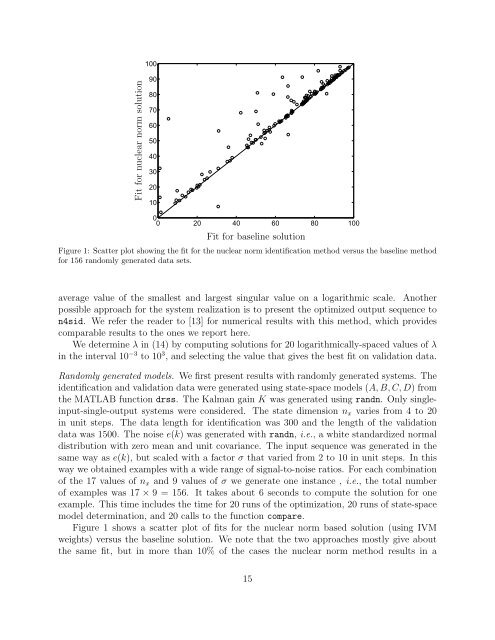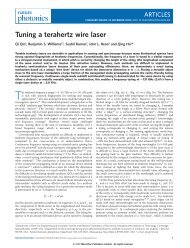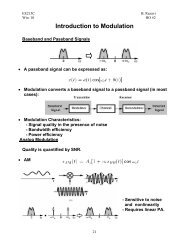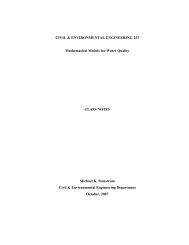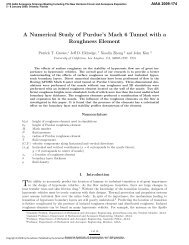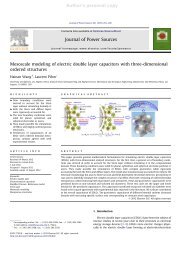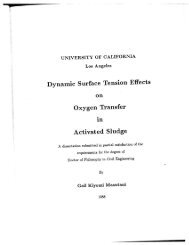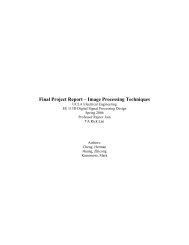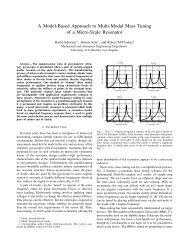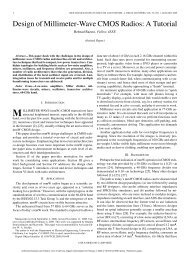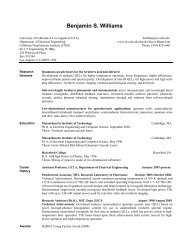Nuclear norm system identification with missing inputs and outputs
Nuclear norm system identification with missing inputs and outputs
Nuclear norm system identification with missing inputs and outputs
You also want an ePaper? Increase the reach of your titles
YUMPU automatically turns print PDFs into web optimized ePapers that Google loves.
100Fit for nuclear <strong>norm</strong> solution90807060504030201000 20 40 60 80 100Fit for baseline solutionFigure 1: Scatter plot showing the fit for the nuclear <strong>norm</strong> <strong>identification</strong> method versus the baseline methodfor 156 r<strong>and</strong>omly generated data sets.average value of the smallest <strong>and</strong> largest singular value on a logarithmic scale. Anotherpossible approach for the <strong>system</strong> realization is to present the optimized output sequence ton4sid. We refer the reader to [13] for numerical results <strong>with</strong> this method, which providescomparable results to the ones we report here.We determine λ in (14) by computing solutions for 20 logarithmically-spaced values of λin the interval 10 −3 to 10 3 , <strong>and</strong> selecting the value that gives the best fit on validation data.R<strong>and</strong>omly generated models. We first present results <strong>with</strong> r<strong>and</strong>omly generated <strong>system</strong>s. The<strong>identification</strong> <strong>and</strong> validation data were generated using state-space models (A,B,C,D) fromthe MATLAB function drss. The Kalman gain K was generated using r<strong>and</strong>n. Only singleinput-single-output<strong>system</strong>s were considered. The state dimension n x varies from 4 to 20in unit steps. The data length for <strong>identification</strong> was 300 <strong>and</strong> the length of the validationdata was 1500. The noise e(k) was generated <strong>with</strong> r<strong>and</strong>n, i.e., a white st<strong>and</strong>ardized <strong>norm</strong>aldistribution <strong>with</strong> zero mean <strong>and</strong> unit covariance. The input sequence was generated in thesame way as e(k), but scaled <strong>with</strong> a factor σ that varied from 2 to 10 in unit steps. In thisway we obtained examples <strong>with</strong> a wide range of signal-to-noise ratios. For each combinationof the 17 values of n x <strong>and</strong> 9 values of σ we generate one instance , i.e., the total numberof examples was 17 × 9 = 156. It takes about 6 seconds to compute the solution for oneexample. This time includes the time for 20 runs of the optimization, 20 runs of state-spacemodel determination, <strong>and</strong> 20 calls to the function compare.Figure 1 shows a scatter plot of fits for the nuclear <strong>norm</strong> based solution (using IVMweights) versus the baseline solution. We note that the two approaches mostly give aboutthe same fit, but in more than 10% of the cases the nuclear <strong>norm</strong> method results in a15


